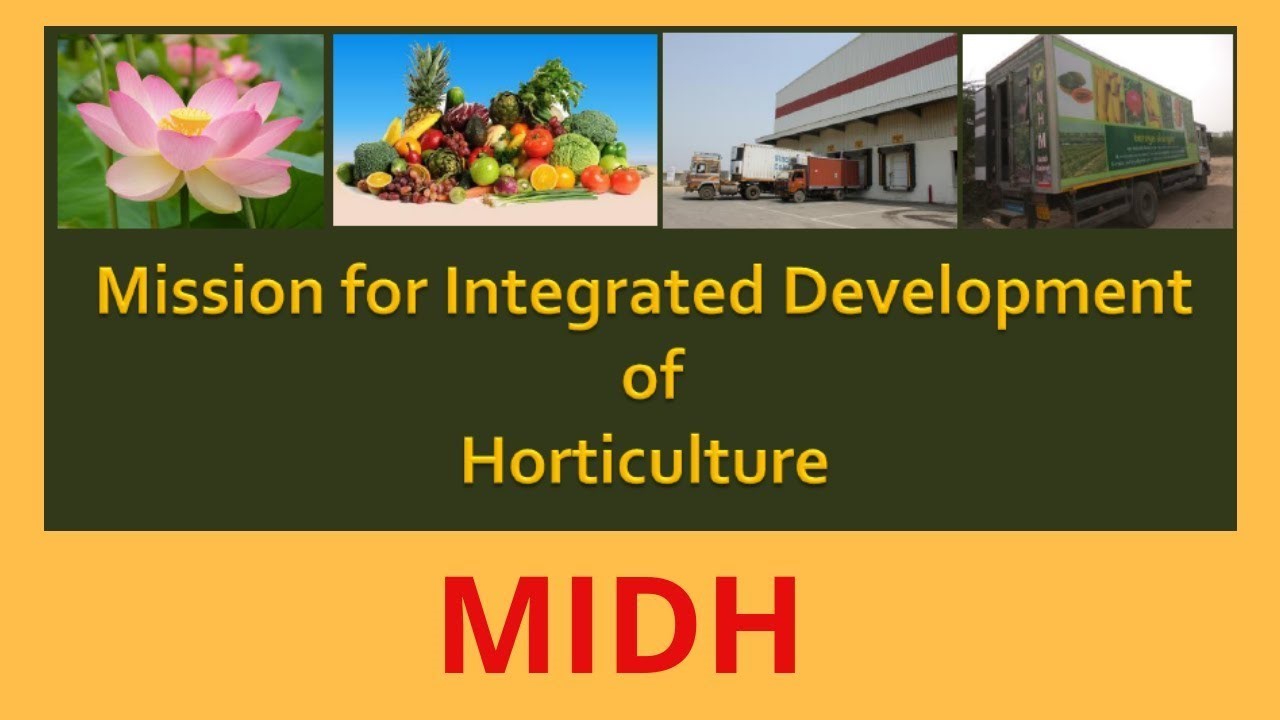MIDH is a Centrally Sponsored plan for the holistic growth of the horticulture sector covering bamboo, cocoa, aromatic plants, cashew, coconut, flowers, root & tuber crops, spices, mushrooms, vegetables, and fruits.
Contents
What is the MIDH Scheme?
- This Centrally Sponsored yojana covers cocoa, cashew, coconut and bamboo, spices, flowers, aromatic plants, tuber crops, roots, fruits, and vegetables.
- MIDH also offers technical advice and support to state horticultural missions, the National Mission for Sustainable Agriculture (NMSA), Rashtriya Krishi Vikas Yojana (RKVY), and Saffron Mission.
- Mission for Integrated Development of Horticulture is coming under the Ministry of Agriculture and Farmers’ Welfare, GOI.
- The structure to refine the horticulture chunk employed by the yojana includes marketing, processing, extension, post-harvest management, research, and technology promotion. The yojana emphasizes utilizing differentiated plans for various states based on the region’s agro-climatic features.
MIDH Objectives
The major aim of this yojana is to promote the progress of the horticulture sector in the nation.
- The yojana forecast the accumulation of farmers into farmers’ groups like FIGs/FPOs and FPCs to:
- Attain economies of scale
- Augment horticulture production
- Intensify farmers’ incomes
- Improve nutritional security
- Enhance productivity by the manner of water utilization efficiency through micro-irrigation, quality germ-plasm, and planting material
- Help skill development
- Create employment for rural youth in the cold chain sector, in horticulture, and also in post-harvest management.
- The yojana also forecast the capacity building of farmers in adopting better technology through existing institutions like Institutes with the Department of Horticulture in the States, Krishi Vigyan Kendras, and state agriculture universities.
What are the major objectives of the National Horticulture Mission?
Main objectives of Mission
- Encourage holistic progress of horticulture sector, including coconut and bamboo through area-based regionally differentiated strategies, which involves processing and marketing, post-harvest management, extension, technology promotion, research, in agreement with comparative benefit of each region/state and its diverse agro-climatic features.
- Promote accumulation of farmers into farmer groups such as FPCs /FPOs and FIGs to bring economy of scope and scale.
- Intensify income and build up nutritional security, augment farmers and horticulture production.
- Upgrade productivity by water use efficiency through Micro Irrigation, way of quality germplasm, and planting material.
- Help skill development and develop employment generation opportunities for rural youth in post-harvest management and horticulture, mainly in the cold chain sector
Activities for which financial assistance is offered
Under MIDH, financial assistance is given for the following major interventions/activities:
- Set up nurseries, tissue culture units for production of planting material and quality seed.
- Area expansion i.e. initiation of gardens and new orchards for flowers, fruits, and vegetables. · Rejuvenation of senile, unproductive, and old orchards.
- Protected cultivation, i.e. green-house, poly-house, etc, to refine the productivity & grow off-season high-value flowers and vegetables.
- Certification and Organic farming.
- Creation of watershed management and water resources structures.
- Bee-keeping for pollination.
- Horticulture Mechanization.
- Creation of Marketing infrastructure and Post Harvest Management.
Key elements of the mission
- Baseline survey
- Panchayati Raj institutions Involvement
- Area-based Perspective and Annual Plans based on end to end approach with forward and backward linkages
- Applied Research with an aim on Region
- Demand-driven production establish on a cluster approach
- Availability of planting material and quality seeds
- Technology-driven programs to refine quality and productivity, e.g.
- Introduction of refined varieties.
- Rejuvenation with refined cultivars.
- High-Density Plantations.
- Utilization of Plastics.
- Beekeeping for cross-pollination
- Capacity building of personnel and farmers
- Mechanization
- Demonstration of latest technologies
- cold chain and Post Harvest Management
- Marketing infrastructure development
- Meticulous monitoring and reporting
- Analysis, Database generation, and compilation
MIDH Sub-Schemes
The Mission includes the following sub-schemes:
- National Horticulture Mission (NHM): It is executed by State Horticulture Missions and is focused on raising production in the horticulture sector.
- National Horticulture Board (NHB): It executed the different schemes under the MIDH at the UT and state levels.
- Horticulture Mission for North East & Himalayan States (HMNEH): It is executed by the State Horticulture Missions of the Northeastern and Himalayan states.
- Coconut Development Board (CDB): It executed the yojana of the MIDH in all the coconut-growing states in the nation.
- CIH, Nagaland: The institute was set up in Nagaland in 2006-07 for offering technical backstopping through training and capacity building of farmers and Field functionaries in the NE Region.
- National Bamboo Mission (NBM)
What do you mean by MIDH?
MIDH is a Centrally Sponsored yojana for the holistic growth of the horticulture sector covering coconut, aromatic plants, root & tuber crops, bamboo, cocoa, cashew, vegetables, fruits, flowers, spices, and mushrooms.
What has been the achievement of Mission for Integrated Development of Horticulture?
The initiative of MIDH has not only resulted out in India’s self-sufficiency in the horticulture sector but also contribute towards attaining sustainable development goals of no poverty, gender equality, good health and wellbeing, zero hunger, etc.
MIDH Strategies
The strategies adopted by the mission to attain its stated objectives are discussed here.
- Adopt an end-to-end infinite way covering processing, production, post-harvest management, marketing, and pre-production to certain appropriate returns to producers/farmers.
- Encourage R&D technologies for post-harvest management, cultivation, and production, and processing with specific emphasis on cold chain infrastructure to increase the shelf life of biodegradable products.
- Augment productivity through:
-
- Diversification from traditional crops to orchards, bamboo plantations, vegetable gardens, flowers as well as vineyards.
- Add on of appropriate technology to farmers for high-tech horticulture including precision farming and protected cultivation.
- Increase the acreage of plantation and orchards crops including coconut and bamboo, particularly in states where the complete zone under horticulture is less than 50% of the agricultural region.
- Better marketing infrastructure, post-harvest management, and processing for value addition.
- Embrace a coordinated approach and encourage convergence, partnership, and synergy among R&D, marketing, and processing agencies in private as well as public sectors, at the state, sub-state, national and regional levels.
- Enhance Farmer Producer Organisations and their tie-up with Financial Institutions (FIs) and Market Aggregators (MAs) to provide and support sufficient returns to farmers.
- Help human resource development and capacity-building at all levels, including, change in curriculum and syllabus of graduate courses at Polytechnics, Universities, ITIs, Colleges, as appropriate.




